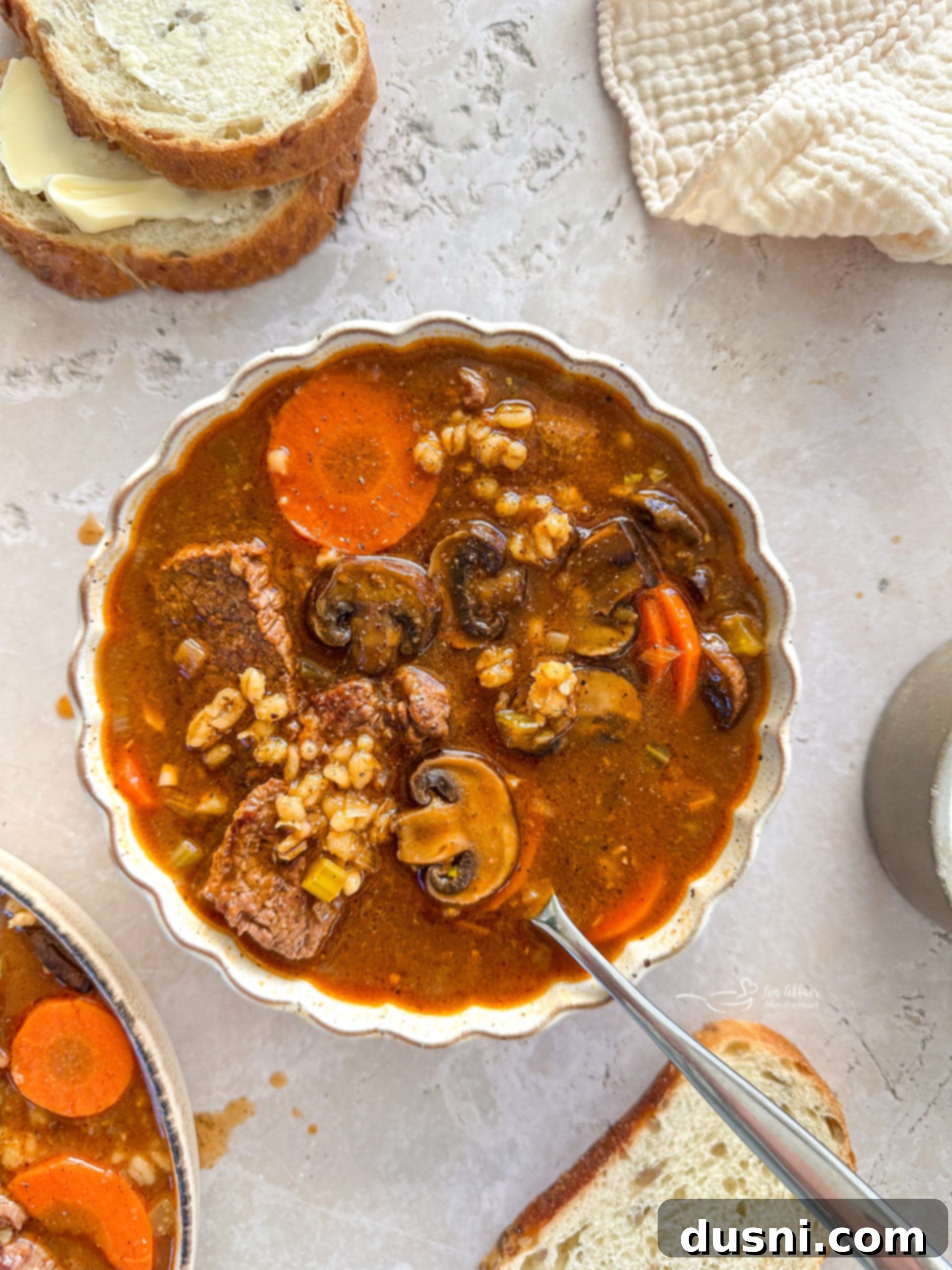Hearty Vegetable Beef Barley Soup with Mushrooms: The Ultimate Comfort Food Recipe
There’s nothing quite like a warm, comforting bowl of homemade soup to chase away the chill of a cool day. This **Vegetable Beef Barley Soup with Mushrooms** is the epitome of comfort food, offering a rich, satisfying experience with every spoonful. It’s a robust and flavorful meal, generously packed with tender chunks of beef, two varieties of earthy mushrooms, and wholesome barley. This recipe truly embodies the essence of slow-simmered goodness, making it taste like it’s been cooking all day, yet it’s surprisingly straightforward to prepare for a convenient weeknight dinner or a leisurely weekend meal.
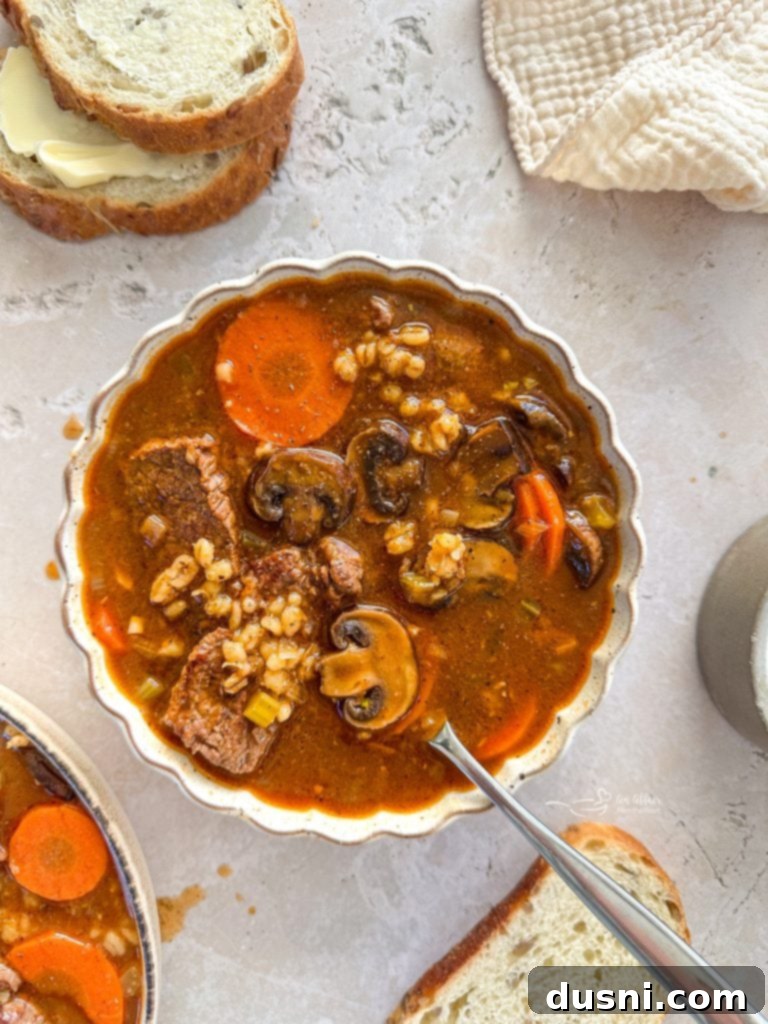
When the weather turns crisp, a truly hearty soup becomes a staple, and this particular Vegetable Beef Barley Soup with Mushrooms delivers on every front. It’s warm, incredibly filling, and bursting with flavor from succulent beef, a delightful blend of baby portabella and white mushrooms, and nutritious barley grains. A thoughtful selection of simple, quality ingredients comes together to create a cozy, comforting meal that’s ideal for those chilly days when you need something substantial and soul-warming.
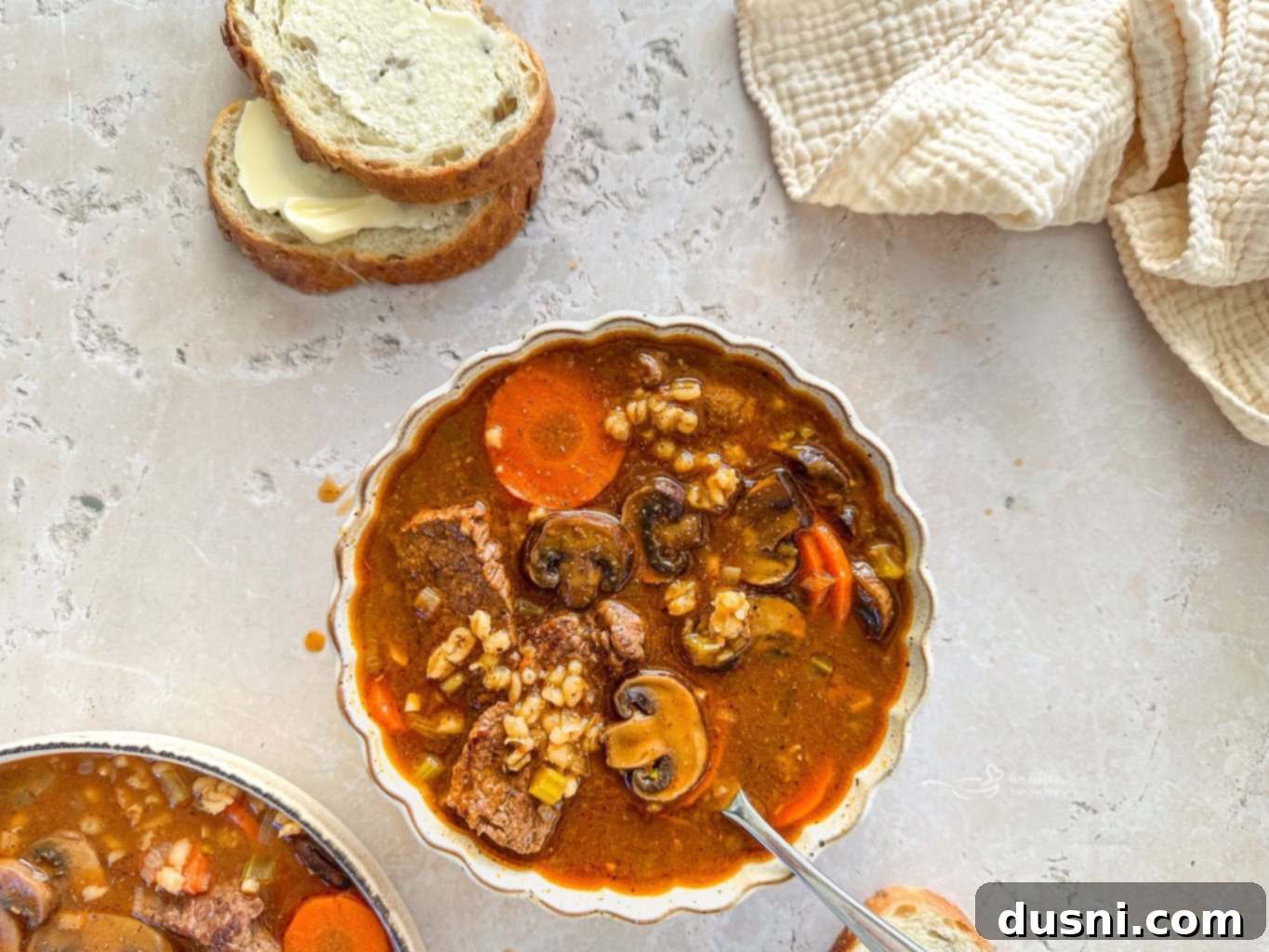
The Enduring Appeal of Our Hearty Beef Barley Mushroom Soup
This particular recipe for Beef Barley Mushroom Soup has been a beloved staple on our table since 2014, originally inspired by a version I discovered in a Hyvee magazine. Over the years, I’ve made a few small, but impactful, tweaks to perfect its rich and well-balanced flavor profile. What truly sets this soup apart is its wonderful texture, derived from a generous assortment of vegetables and the hearty chewiness of barley. The inclusion of nice, big chunks of stew meat ensures that this soup is a complete and satisfying meal, capable of appeasing even the hungriest appetites. For the ultimate experience, serve it alongside some cheesy cornbread biscuits or a slice of warm, crusty Dutch oven bread, perfect for soaking up every last drop of the savory broth.

Unlocking Deep Flavors in Your Vegetable Beef, Barley & Mushroom Soup
Every bowl of this beef soup delivers all the comfort and robust flavor you’d expect from a cherished home-cooked meal. In fact, its taste only deepens and improves after a day in the refrigerator, as the ingredients meld together even further. The combination of mushrooms, particularly a thoughtful mix of varieties, contributes a profound, umami-rich savory flavor that forms a perfect partnership with the tender beef and hearty barley. A crucial, yet often overlooked, secret ingredient is a splash of fresh lemon juice added right at the end of cooking. This brightens the entire profile of the soup, cutting through the richness and adding a delightful zing that elevates all the other flavors. Whether you choose to simmer this soup on the stovetop or let it gently bubble away in a slow cooker, the process itself fills your entire home with an incredibly inviting aroma, signaling that a truly special meal is on its way.
Cooking with Barley: A Guide to Perfect Texture and Nutrition
Barley is a fantastic grain for soups, adding body, nutrition, and a satisfying chew. However, it comes in several forms, and understanding their differences is key to achieving the desired texture and managing your cooking time. Knowing which type to use can significantly impact your soup’s final consistency and the overall experience, whether you’re aiming for a rustic whole-grain bite or a quicker, softer addition.
- Hulled Barley (Barley Groats): This is considered a true whole grain, as only the tough, inedible outer husk has been removed. It boasts a distinctively chewy and nutty texture, making it a favorite for those who appreciate a rustic feel and maximum fiber content. Due to its minimal processing, hulled barley requires the longest cooking time, often an hour or more, to become tender. It’s excellent for hearty, slow-cooked soups where you want the grain to maintain its integrity and nutritional benefits.
- Hulless Barley: Similar to hulled barley, hulless barley retains most of its bran and germ, making it another whole-grain option with a robust nutritional profile. The difference is that its hull naturally separates during harvest, requiring less abrasive processing than hulled barley. This makes it slightly quicker to prepare while still preserving the wholesome, chewy character and health benefits of a whole grain. It’s a great compromise between speed and whole-grain goodness, often found in specialty health food stores.
- Pearl Barley: This is the most common type found in grocery stores and what most traditional recipes typically refer to. Pearl barley has had its bran layer polished away, which means it’s no longer technically a whole grain, but it cooks significantly faster and becomes soft and tender. This makes it ideal for soups where you want a smoother texture without an excessively long simmer. It still retains a pleasant chewiness and contributes a lovely creaminess to the broth, helping to thicken the soup naturally.
- Quick (or Quick-Pearled) Barley: For those busy weeknights or when time is of the essence, quick barley is your best friend. This variety is pre-cooked or partially steamed, allowing it to cook in a fraction of the time compared to regular pearl barley. It’s perfect for adding to soups toward the end of the cooking process to ensure it’s tender without becoming mushy, making it a truly convenient option for a quick beef barley soup.
- Does barley need to be cooked before adding to soup? The straightforward answer is no, it’s generally not necessary. You can add uncooked barley directly into your soup, and it will absorb the flavorful broth and cook to tender perfection as the soup simmers. However, the type of barley matters significantly for timing. Hulled or hulless barley will require a longer simmering period (often 60-90 minutes or more) to become fully tender, whereas pearled or quick barley cooks in much less time (15-45 minutes), allowing you to adjust based on your schedule and the desired tenderness.
- What kind of barley should I use for this recipe? For this particular Vegetable Beef Barley Soup recipe, quick barley is highly recommended. Its advantage lies in its rapid cooking time, typically softening in just 10–15 minutes, ensuring it remains tender without turning mushy. This makes it ideal for achieving a delicious, hearty soup even on busy weeknights. If quick barley isn’t available, regular pearled barley is a suitable substitute, but be prepared to extend the simmering time by about an hour to an hour and a half until the grains are delightfully soft and chewy. If using hulled or hulless barley, consider soaking it overnight or pre-cooking it for best results, or simply account for a much longer cook time in the soup itself to achieve optimal tenderness.
- Does barley thicken soup? Absolutely, and this is one of its wonderful benefits in soup! As barley cooks, it naturally releases starch into the broth. This starch acts as a gentle thickener, giving the soup a richer body and a more substantial mouthfeel. This contributes to the overall hearty and comforting texture of the soup. If you prefer a thinner consistency, simply add an extra cup of beef broth or water towards the end of the cooking process to reach your desired texture without diluting the flavor significantly.
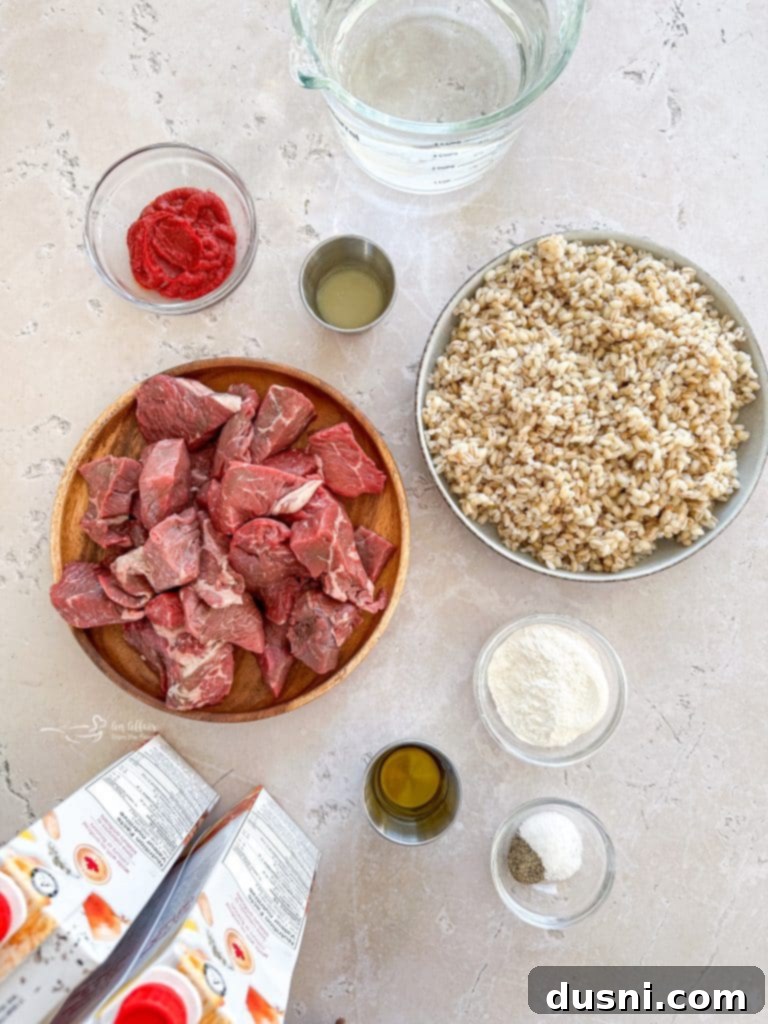
Essential Ingredients for Our Old-Fashioned Beef and Mushroom Barley Soup
Crafting this flavorful and hearty soup begins with a selection of fresh, high-quality ingredients. You’ll find the precise amounts and detailed instructions conveniently located in the printable recipe card at the very bottom of this post, but let’s dive into some key components and why they make this soup so special, along with possible substitutions and tips.
- Flour, Salt, and Black Pepper: This simple seasoning blend is crucial for developing a deep, savory flavor. Coating the beef in flour not only helps achieve a beautiful, caramelized sear—which locks in juices and builds rich flavor—but also contributes to thickening the broth slightly as it simmers, creating a more substantial and luxurious texture. For those managing gluten sensitivities, a 1:1 gluten-free flour blend works perfectly, or you can opt for cornstarch or arrowroot starch for a similar thickening effect without gluten.
- Beef Stew Meat: The star of the show! Any cut of beef that’s suitable for stewing, typically pre-cubed, will work wonderfully. Look for cuts like chuck roast, round roast, or even sirloin tip, as these become incredibly tender and flavorful when simmered slowly in the rich broth. They are ideal for absorbing the soup’s aromatic liquids. Trimming any excess visible fat before browning is recommended for a cleaner soup.
- Olive Oil: Essential for browning the beef and sautéing the aromatics. A good quality olive oil adds a subtle flavor base and helps create that desirable crust on the meat. If you prefer, avocado oil or canola oil are also excellent neutral alternatives that stand up well to high heat without imparting an overpowering flavor.
- Beef Stock and Water: Using a combination of good quality beef stock (or broth) and water achieves a balanced richness without making the soup overly salty or heavy. The stock provides a savory foundation, while water helps to keep the overall flavor from becoming too concentrated. For an even deeper, more intense beef flavor, feel free to use all beef broth. If you’re mindful of sodium intake, low-sodium beef broth is a fantastic option, allowing you to control the seasoning precisely to your preference.
- Quick Barley: As discussed, quick barley is our preferred choice for its efficient cooking time, making this hearty soup achievable even on busy weeknights. Its quick-cooking nature means less waiting for tender grains. If you only have regular pearled barley, remember to adjust your simmering time accordingly (about an hour longer), or consider pre-cooking it separately before adding it to the soup to ensure it reaches perfect tenderness without absorbing too much broth from the main pot.
- Tomato Paste: A small but mighty ingredient, tomato paste adds a concentrated umami depth and a subtle tang that perfectly complements the savory beef and earthy mushrooms. It contributes a beautiful richness and a hint of sweetness and color to the broth that’s hard to achieve otherwise, creating a more complex flavor profile.
- Lemon Juice: Please do not skip this! A generous splash of fresh lemon juice at the very end of cooking is a game-changer. It provides a bright, acidic finish that perfectly balances the rich, hearty flavors of the soup, cutting through any heaviness, waking up your taste buds, and adding a delightful zing that elevates all the other components. It truly makes the flavors pop.
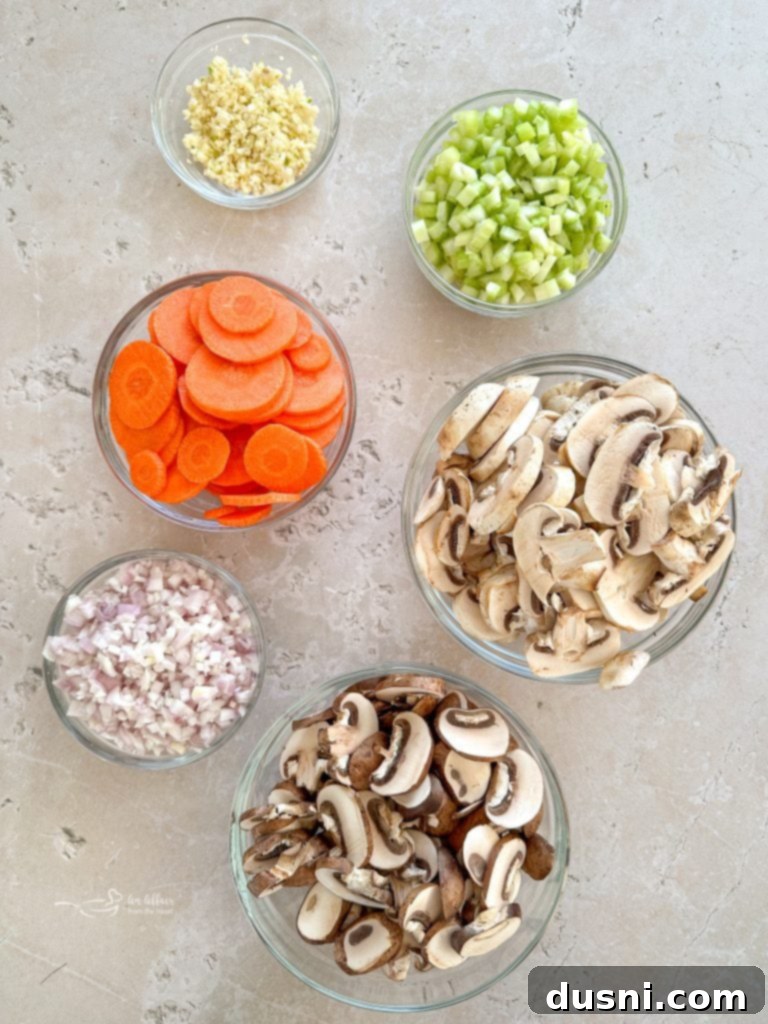
- Shallots and Garlic: These aromatic powerhouses form the foundational flavor of the soup. Shallots impart a delicate sweetness and milder onion flavor compared to regular onions, offering a refined base. However, a medium yellow onion, finely chopped, can be substituted if that’s what you have on hand, providing a slightly bolder onion note. Freshly minced garlic adds an indispensable pungent depth and aroma that is essential for any savory soup.
- Carrots and Celery: The classic mirepoix vegetables are essential for any comforting soup. They bring vibrant color, a pleasant texture, and a foundational savory sweetness to the broth as they slowly cook down. Using carrot “chips” or coins (pre-sliced carrots) is a smart trick, as they tend to hold their shape nicely during prolonged simmering, preventing them from becoming too soft or mushy while still imparting their flavor.
- Thyme: This aromatic herb adds an earthy, slightly minty, and subtly floral note that pairs exceptionally well with beef and mushrooms, enhancing the overall savory profile. While it’s optional, and you can certainly skip it if it’s not to your taste, a pinch of dried thyme (or a few fresh sprigs tied with kitchen twine, removed before serving) can significantly elevate the soup’s complexity. Italian seasoning or a hint of rosemary makes a lovely alternative if you want to experiment with different herb profiles.
- Mushrooms (Baby Portabella & White): Using a combination of baby portabella (also known as cremini) and white button mushrooms creates a perfect balance of flavor and texture. Baby portabellas offer a richer, earthier, and meatier flavor, providing a robust depth. White mushrooms, on the other hand, provide a milder, more delicate taste. Slicing them uniformly ensures even cooking and distribution throughout the soup, and they absorb the rich broth wonderfully.
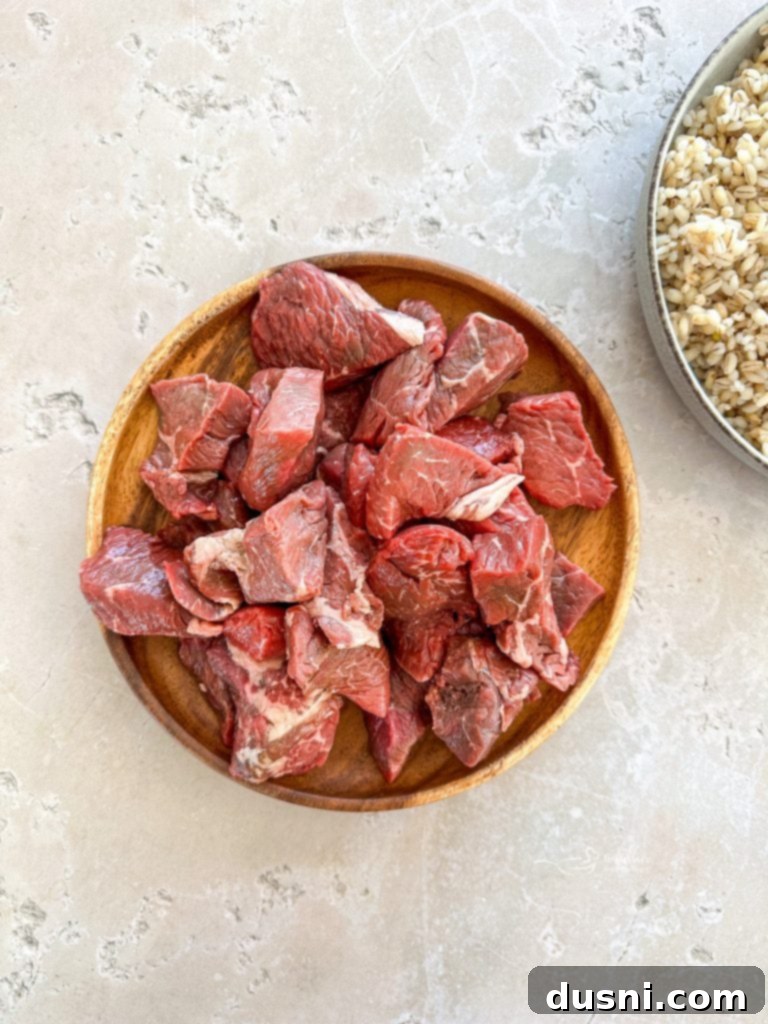
Step-by-Step: How to Make Hearty Beef Barley Soup with Mushrooms
This versatile soup can be prepared using either the classic stovetop method for a hands-on approach or with the convenience of a slow cooker, perfect for setting and forgetting. Both methods yield equally delicious results, allowing you to choose what best fits your schedule and cooking preferences.
Stovetop Method Instructions:
- Prepare the Beef: Begin by heating a generous swirl of olive oil (about 2-3 tablespoons) in a large, heavy-bottomed stockpot or Dutch oven over medium heat. While the oil is heating, combine the flour with ½ teaspoon of salt and ¼ teaspoon of black pepper in a shallow bowl. Toss the beef stew meat in this seasoned flour mixture until each piece is lightly coated. This flour coating will help create a beautiful sear and subtly thicken the soup later.
- Brown the Beef: Carefully add the coated beef to the hot pot in a single layer, ensuring not to overcrowd the pot. If necessary, work in batches to achieve proper browning. Sear the beef on all sides until a rich, golden-brown crust forms. This step is crucial for building deep, caramelized flavor that will infuse into the broth. Once browned, remove the beef from the pot and set it aside.
- Sauté Aromatics: Add another tablespoon or two of olive oil to the pot if needed to replenish the fat. Then, add the chopped shallots and minced garlic. Sauté them gently for about 5 minutes, stirring occasionally, until they become tender, translucent, and wonderfully fragrant. Be careful not to burn the garlic, as this can turn bitter and affect the soup’s flavor.
- Add Vegetables and Seasoning: Stir in the sliced mushrooms, carrots, and chopped celery to the pot. Add the dried thyme (if using) and any remaining salt and pepper to the vegetables. Sauté for another 5-7 minutes, allowing the vegetables to soften slightly and release their natural flavors and moisture.
- Combine and Simmer: Pour in the beef broth and water, then stir in the tomato paste until it’s fully dissolved and incorporated into the liquid. Return the browned beef to the pot, ensuring it’s nestled among the vegetables. Finally, add the quick barley. Bring the entire mixture to a rolling boil over medium-high heat.
- Cook to Perfection: Once boiling, immediately reduce the heat to low. Cover the pot tightly and let it simmer gently for 45–60 minutes, or until the beef is fork-tender and the barley is soft and chewy. The longer, slower simmer allows the flavors to meld beautifully and the ingredients to become perfectly tender.
- Finish with Lemon Juice: Just before serving, remove the pot from the heat and stir in the fresh lemon juice. This brightens the soup beautifully and adds a refreshing, tangy counterpoint to the rich, savory flavors. Taste and adjust seasonings as needed, adding more salt or pepper if desired.
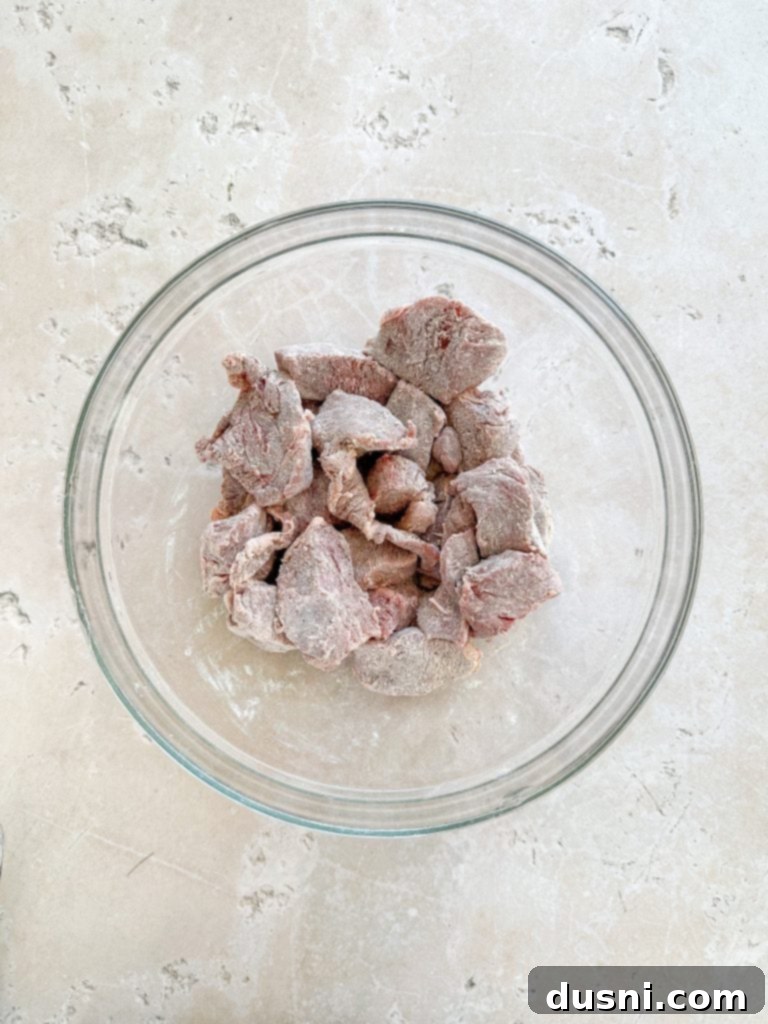
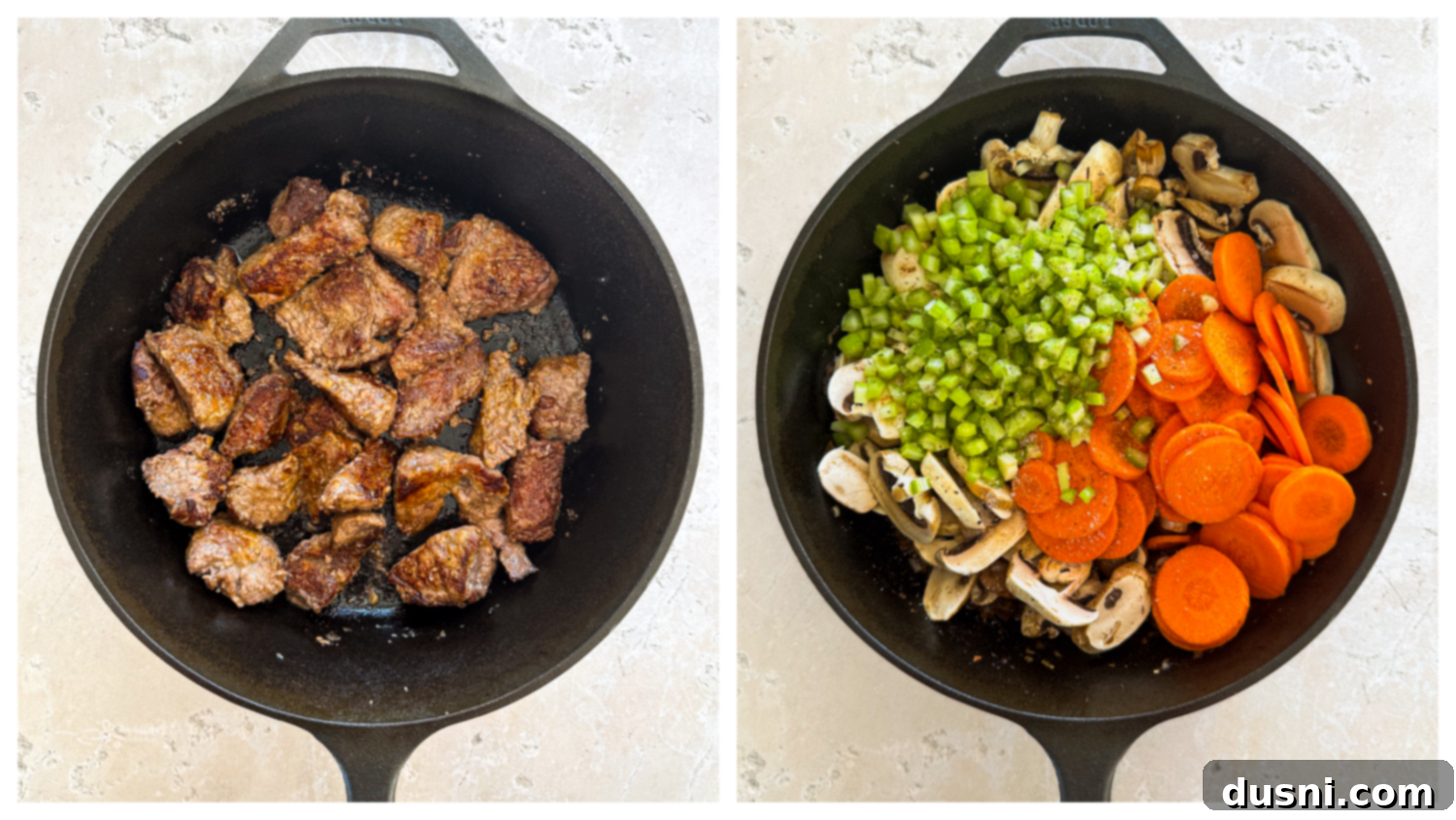
Slow Cooker Method Instructions:
- Pre-Cook Beef & Aromatics: Even for the slow cooker, browning the beef and sautéing the aromatics on the stovetop first is highly recommended. This crucial step significantly deepens the flavor of your soup, creating a richer, more complex base that you simply can’t achieve by dumping raw ingredients into the slow cooker. Follow steps 1-3 from the stovetop method: coat and brown the flour-coated beef, remove and set aside. Then, sauté the shallots and garlic until tender and fragrant in the same pot.
- Assemble in Slow Cooker: Transfer the browned beef, sautéed shallots, and garlic to your slow cooker pot. Add all remaining ingredients: sliced mushrooms, carrots, chopped celery, thyme (if using), beef broth, water, quick barley, and tomato paste. Stir everything together thoroughly to ensure all ingredients are well combined and submerged in the liquid.
- Cook Low and Slow: Cover the slow cooker with its lid and cook on the LOW setting for 6–7 hours. This extended, gentle cooking time will ensure the beef becomes incredibly tender, almost melting in your mouth, and the flavors fully meld together into a harmonious and deeply satisfying soup.
- Finish with Lemon Juice: Just before serving, stir in the fresh lemon juice. As with the stovetop method, this final touch brightens the overall flavor profile beautifully, adding that essential lift and balance to the rich, slow-cooked ingredients.


Storing and Reheating Your Delicious Leftover Soup
One of the many advantages of this Vegetable Beef Barley Soup is how wonderfully it stores, making it an ideal candidate for meal prep or simply enjoying delicious leftovers for days. The flavors actually deepen and improve over time, making it even more satisfying on subsequent servings as the ingredients have more time to meld.
Refrigerator Storage: To store, first allow any leftover soup to cool completely to room temperature. This is important to prevent bacterial growth and to ensure the soup cools evenly. Once cooled, transfer it to an airtight container. Store it in the refrigerator for up to **4–5 days**. When you’re ready to reheat, you might notice that the soup has thickened considerably – this is perfectly normal! The barley continues to absorb liquid as it sits, especially in the cold. To restore it to its original consistency, simply add a splash of extra beef broth or water (or even a little milk for creaminess, if desired) as you gently reheat it on the stovetop over low heat or in the microwave, stirring occasionally until warmed through.
Freezer Storage: This soup also freezes exceptionally well, allowing you to enjoy its comforting goodness for much longer periods, up to several months. Ensure the soup has cooled completely before freezing. Transfer it to freezer-safe containers, leaving about an inch of headspace to allow for expansion as it freezes, or use heavy-duty freezer bags (laying them flat for efficient, space-saving storage). It will keep beautifully in the freezer for up to **3 months**. A small note on barley: if you used hulled or hulless barley, it might become slightly chewier after freezing and thawing, as its tougher outer layers can change texture. However, quick or pearled barley tends to maintain its texture better in the freezer, making it a superior choice for freezer-friendly meal planning. When you’re ready to enjoy, thaw the soup overnight in the refrigerator for best results, then reheat gently on the stove or in the microwave, adding liquid as needed to achieve your preferred consistency and ensure it’s piping hot.

Enjoying and Sharing Your Favorite Recipes
If you’ve fallen in love with this rich and hearty Vegetable Beef Barley Soup recipe as much as we have, make sure you keep it handy for future cooking adventures! Don’t forget to save it to your favorite Pinterest recipe board before you go, so you can easily find it whenever a craving for comforting soup strikes. Sharing is caring, and this recipe is definitely worth sharing with family and friends who appreciate a truly wholesome and satisfying homemade meal.
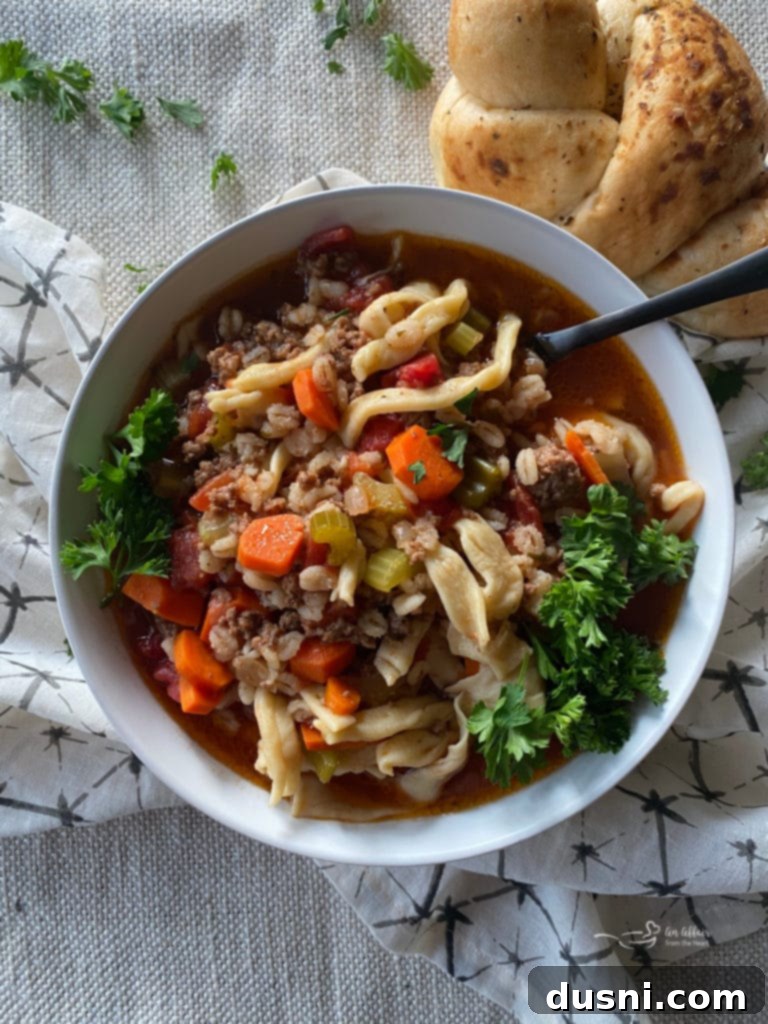
More Beloved Soup Recipes to Warm Your Soul
For those of us who believe soup season is year-round, my website is a treasure trove of diverse and delightful soup recipes to enjoy! Whether you’re in the mood for something light, hearty, creamy, or spicy, there’s a perfect bowl waiting for you. If you were considering a vegetable beef soup but perhaps with ground beef instead of stew meat, you absolutely must try my Grandma’s Hamburger Soup (pictured above!). It’s a nostalgic favorite and incredibly satisfying, especially when you can customize it with or without noodles. Another cherished family recipe is my Mom’s Homemade Chicken Noodle Soup, perfect for a cold or just a cozy night in, brimming with fresh vegetables and tender chicken. And let’s not forget the timeless classics that always hit the spot, offering a comforting embrace: a robust Three Bean Chili packed with protein and flavor, the unique and savory notes of Cincinnati Chili, a comforting bowl of Fire-Roasted Tomato Soup with its smoky depth, or the ultimate creamy indulgence, Cheesy Potato Soup. You can explore a wide variety of more soup recipes right here, ensuring your soup pot is never empty and your belly always full!

This Vegetable Beef Barley Soup with Mushrooms is undoubtedly a recipe you’ll want to integrate into your regular meal rotation. It’s an effortless yet incredibly wholesome dish, brimming with that cherished from-scratch flavor that transforms everyday homemade meals into something truly special. We encourage you to give it a try, gather your loved ones around the table, and savor its comforting warmth. If you do make this delicious soup, please take a moment to share your experience and how it turned out in the comments section below. Your valuable feedback and star ratings are incredibly meaningful and help our community of home cooks, inspiring others to try this delightful recipe!

LIKE THIS RECIPE?
Don’t forget to give it a ⭐️⭐️⭐️⭐️⭐️ star rating and
leave a comment below the recipe!


